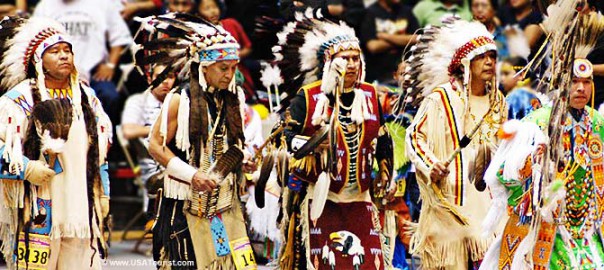Preface
Of all the subjects and issues on Agenda 21 there have been none which match the level of UN and federal government corruption and fraud than the exploitation of Tribes and attacks on private property.
Understanding Tribal History & Federal Government Relations
It is well known that the United Nations (UN) uses partnerships with professional organizations, businesses, governments, and non-profit groups to advance their agenda and ideology.
But the UN is using another group, Tribes. Through the UN and federal government cartel for Sustainable Development (SD), aka Agenda 21 implementation, Tribes are being used to confiscate more resources, land, and private property. Tribal issues regarding land and water in the U.S. are extremely complex, involving multiple case decisions, Acts, settlements, and federal laws. The U.S. has had a troubled relationship with Native American Tribes from the beginning with malfeasance, and all that it implies, by the federal government, but never at the level that exists today. A review of that history is necessary to understand the current Tribal disputes regarding land and water, and how the federal government is using that history against Americans for UN agenda gains. Following are the more significant past laws that affect current decisions regarding Tribal land.
In 1452, forty years prior to Columbus landing on this new land, “…the Dum Diversas Bull, a papal bull (aka an edict), was issued by Pope Nicholas V, granting the blessing to “capture, vanquish and subdue the Saracens, pagans and other enemies of Christ and put them into perpetual slavery and to take all their possessions and their property.” In 1493, one year after Columbus discovered this new land, Pope Alexander VI’s papal bull issued the Inter Caetera which granted the same to Spain. These declarations came to be known as the Doctrine of Discovery. The Doctrine’s foundation was the ability to take land, private property, and rights from non-Christian inhabitants in newly discovered land. The UN uses these 522 year old papal bulls as a basis for the initial wrongful violation of indigenous rights across the world. The Doctrine of Discovery has been cited in Supreme Court cases regarding Tribal rights since that time.
There have been numerous treaties and laws regarding Tribal rights over the years, including ones that involved water and land, but to this day Tribal status decisions have been primarily based on the Doctrine of Discovery.
The 1887 Dawes Act placed Tribes and individual Native Americans on allotted land, opened up non-allotted land to non-native settlement, with surplus land usurped by the government; The Indian Reorganization Act of 1934 reversed the Dawes Act, restored surplus land to Tribes, and authorized the government to acquire land, water and surface rights for Indians, and extended the placement of land into federal government trust; the 1950’s Termination policies terminated some Tribes, removed land from trust status, extended state jurisdiction over land, and initiated relocation programs; and the 2000 Indian Land Consolidation Act Amendments gave the government the ability to consolidate fragmented Tribal land resulting from the previous decisions.
Over the years there have been federal laws passed, and repealed, to reverse past injustices and litigation challenging the same. It was during the 60’s when Indian activists took a role in bringing Native American rights to the forefront. As a result, laws began to focus more on Tribal self-determination and self-governance, rather than being a “domestic dependent nation” or a “ward to his guardian” (#18). Decisions affecting Tribes would now be made by the Tribes rather than the federal government, although the government still holds authority over the tribes and the land on which they reside.
The federal government holds reservation and other land “in trust” for the tribes, meaning tribes technically do not own title to their lands. The U.S. then administers and manages the land and resources for the fiduciary advantage of the tribe. Recognized as a “sovereign nation or state”, tribes can form tribal governments; determine tribal membership; regulate individual property; levy and collect taxes; maintain law and order; exclude non-members from tribal territory; regulate domestic relations; and regulate commerce and trade. The federal government retains the ultimate power and authority to either abrogate or protect Native American rights while Congress creates regulations that govern the territory belonging to the United States. As legal title-holder to most Indian lands, the U.S. has the power to dispose of and manage those lands, and derive income from them. Due to federal fiduciary mismanagement and the Cobell lawsuit, the Coeur d’Alene Tribe (CDA) alone was awarded 18 million dollars of which 4.1 million will be used to buy back land with the Department of Interior (DOI) assisting. This establishes more land in trust to the federal government.
The CDA people once inhabited 3,500,000 acres in Idaho, Washington, and Oregon. In 1867, President Johnson established a reservation for the tribe at the request of the territorial governor, but it was not accepted by the tribe because the main waterways were not included. After the Tribe ceded almost 2.4 million acres to the government in 1873, negotiations established 598,000 acres for a reservation that included the St. Jo and Coeur d’Alene rivers and a portion of Lake Coeur d’Alene. The remaining land was lost to the allotment process. Congress never approved this agreement. In 1889 the tribe ceded the northern third of the reservation back to the federal government, including part of Lake Coeur d’Alene. When Idaho became a state in 1890 Congress included a section disclaiming the state’s rights to lands owned by tribes in the state constitution, then ratifying the earlier tribal agreements in 1891. In the 2001 Supreme Court case, Idaho v United States, it was determined that the U.S. held title to lands submerged under Lake Coeur d’Alene, holding that land in trust for the CDA Tribe.
In 1909, after 114 allotments were completed, the remaining CDA reservation land was opened to homesteaders. By 1933, 40 per cent of the allotted land was sold. The Coeur d’Alene delegation that went to Washington protesting the allotment process were told, “that because Congress had “given” them their land, Congress had the right to take it away.” This should be an ominous warning to Tribes today when dealing with the federal government as that authority is still held by the government. The federal government now uses land lost to allotment as a method to return land back to Tribes, still holding it “in trust” for the tribes. Other federal fiduciary responsibilities include protecting tribal treaty rights, assets, resources, and carrying out federal law mandates.
The Environmental Protection Agency (EPA) uses these laws to define Tribal land, land in trust, and allotment lands. In the EPA definition of a Federal Indian reservation, the EPA interprets the law in light of Supreme Court case law, that a reservation includes trust lands set apart for a tribe’s use even though not formally designated as a reservation.
The EPA uses different definitions for Indian country. Using an Indian country definition from 1948 under 18 U.S. Code 1151, (c) states: includes all Indian allotments, the Indian titles to which have not been extinguished, including rights-of-way running through the same. This is based on the the 1887 Dawes Act which allotted land to Indians in exchange for land paid for by the government to keep in trust for the tribe. Any surplus lands were taken out of Tribal ownership.
In the Indian Energy Resource Program, the term Tribal Land “…means any land or interests in land owned by a tribe or tribes, title to which is held in trust by the United States…”. Indian Land refers to any land located within or not within the boundaries of an Indian reservation, the title to which is held in trust by the U.S. for the benefit of an Indian Tribe.
The Indian Land Tenure Foundation is devoted to restoring these lands to the Tribes. With federal termination policies Tribal land was removed from trust status and Tribal affiliation. Since that time Tribes have fought to regain that land in addition to having land outside of reservations declared Sacred Sites for their protection and use. Money derived from casino earnings, federal grants and tax dollars, tax free trusts, court settlements, and resource use are used by Tribes to buy land back.
Federally recognized Tribes can be allowed “same treatment as a state (TAS)” status. The EPA was allowed provisions in the Clean Water Act (CWA), Safe Drinking Water Act (SDWA), and Clean Air Act (CAA) to give Tribes with TAS status authority to implement federal environmental law, making them eligible for federal funding. Federally recognized tribes in Idaho include the Coeur D’Alene Tribe, Kootenai Tribe of Idaho, Nez Perce Tribe of Idaho, and Shoshone-Bannock Tribe. The CDA Tribe obtained TAS status in 2005. These tribes also have lobbyists in Idaho.
Although there are multiple other court decisions and laws relating to tribal lands and rights, the essence is that because the federal government has full land and water authority over tribes through trusts, they have developed mechanisms for the tribes to not only recover previously held land but also enforce federal law. This is significant when it comes to both land and water rights. Engaging tribes in environmental regulations, and resource control, gives the government further power to implement Agenda 21.
Part 2 will explore how Tribal land and water rights are being decided by the federal government.



